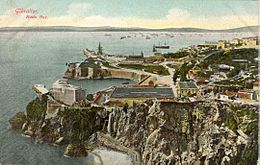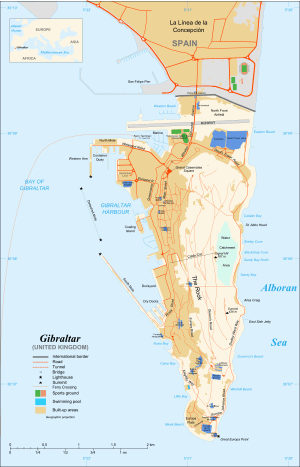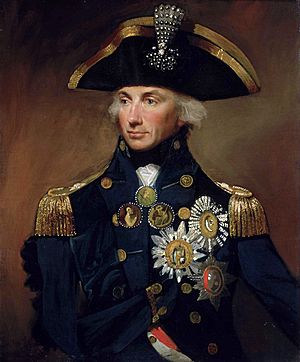Rosia Bay facts for kids
Quick facts for kids Rosia Bay |
|
|---|---|
 |
|
| Location | |
| Country | Gibraltar |
| Location | Bay of Gibraltar |
| Coordinates | 36°07′18″N 5°21′11″W / 36.1218°N 5.3531°W |
| Details | |
| Owned by | Government of Gibraltar |
| Type of harbor | Natural/Artificial |
| Piers | one (Rosia Mole) |
Rosia Bay is a special place in Gibraltar. It is the only natural harbour in this British territory. Gibraltar is located at the southern tip of the Iberian Peninsula. Rosia Bay is on the southwest side of Gibraltar. It was once called Rosia Harbour.
In the early 1800s, the Royal Navy built a large complex here. It was called the Victualling Yard. This yard helped ships get supplies like food and water. A famous naval leader, Vice Admiral Horatio Nelson, got supplies for his ships at Rosia Bay. After he died in the 1805 Battle of Trafalgar, his ship, HMS Victory, was brought to this same bay.
Rosia Bay also has old gun batteries. These include Parson's Lodge Battery at the south end and Napier of Magdala Battery at the north end. In recent years, some changes happened at Rosia Bay. Old water tanks were removed to build new homes.
Contents
The Victualling Yard and Rosia Cottages

Rosia Bay is on the southwestern coast of Gibraltar. It is the only natural harbour in this British territory. The bay was named after Rosia, a town in northern Italy.
For a long time, Rosia Bay was home to the 19th-century Victualling Yard complex. This included the Victualling Yard, Rosia Water Tanks, and Rosia Mole. In 2006, the historic Rosia Water Tanks were taken down. This made way for a new building called Nelson's View. This building provides homes for people. The Victualling Yard and Rosia Mole are still there. Only the entrance to the Victualling Yard complex is a protected historic site.
Four homes called Rosia Cottages were built at Rosia Bay in the 1800s. They were for people who worked at the Victualling Yard. These cottages later became privately owned. After the water tanks were removed and Nelson's View was built, a large building stood behind the cottages. The government made a deal with the cottage owners. They exchanged the cottages for other properties. These properties were Lancashire House, St. Bernard's House, Suffolk House, and Surrey House. They used to belong to the Ministry of Defence.
The Victualling Yard complex has a long history. In the late 1700s, the main dockyard was at the New Mole. This is now called the South Mole. Supplies were kept near the Old Mole, now the North Mole. But these places were damaged during the Great Siege of Gibraltar. This was because they were close to Spanish cannons.
In 1799, Admiral John Jervis, 1st Earl of St Vincent suggested moving the Royal Navy Victualling Yard. He wanted it moved to the Rosia Bay area. This spot was south of the New Mole. It had good access to the bay. It was also protected by Parson's Lodge Battery. Plus, it was out of range of enemy cannons from the north. Building the Rosia Water Tanks started in 1799 and finished in 1804. The whole Victualling Yard complex at Rosia Bay was ready by 1812. It was part of the Royal Navy base. It held large amounts of food, water, and clothing for many ships. The Rosia Mole was where Royal Navy ships docked to get supplies and water. It also held coal for the military base.
Protecting Rosia Bay: Fortifications
Over many years, the British built gun batteries to protect Rosia Bay. These batteries guarded the harbour from enemy ships.
Parson's Lodge Battery
Parson's Lodge Battery is at the south end of the bay. It is the biggest of these defenses and dates back to the 1700s. The battery sits on a high point in front of the Victualling Yard. Engineers shaped the cliffs below it. This was to stop attackers from climbing up. At one time, this battery had three large 10-inch guns. It also had storage for ammunition and living areas for soldiers. Today, Parson's Lodge Battery is looked after by the Gibraltar Museum.
Napier of Magdala Battery
At the north end of Rosia Bay is the Napier of Magdala Battery. It was finished in 1883-1884. It was named after Field Marshal Robert Napier, 1st Baron Napier of Magdala. He was the Governor of Gibraltar from 1876 to 1882. This battery is home to the 100-ton gun. This huge gun was installed in the late 1800s. It is one of only two left in the world. The other is at the Rinella Battery in Malta.
Gibraltar received two of these 100-ton guns in the late 1800s. The British put one at Victoria Battery, named after Queen Victoria. The other was at Napier of Magdala Battery. The gun at Napier of Magdala broke during firing. So, the gun from Victoria Battery replaced it. The old Victoria Battery is now where Gibraltar's City Fire Brigade has its main office.
Gibraltar's 100-ton gun is a protected site with the Gibraltar Heritage Trust. The defensive wall and other batteries on the east side of Rosia Bay are also protected. This includes two rifled muzzle loading guns.
Vice Admiral Horatio Nelson's Connection
The Battle of Trafalgar happened on October 21, 1805. It was a big sea fight between the British fleet and the combined French and Spanish fleets. Vice Admiral Horatio Nelson led the British fleet. The British won the battle, but Admiral Nelson died during the fight.
After the battle, the British fleet returned to Gibraltar. Nelson's body was preserved and brought back on his ship, HMS Victory. Rosia Bay was the only deep water anchorage in Gibraltar. So, HMS Victory was towed into Rosia Bay after this important battle.




